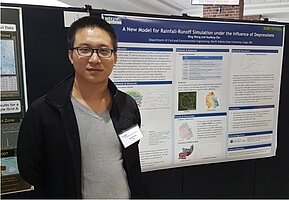Development of a New Depression-oriented Hydrologic Modeling System (HYDROL-D)

Ning Wang is currently enrolled in second year as a Ph D. student in the Department of Civil and Environmental Engineering at North Dakota State University. In addition to doing research, I am a teaching assistant for CE 477/677 Applied Hydrology.
I received my B.S. degree in Groundwater Science and Engineering from Chang’an University in 2013, followed by my M.S. degree in Groundwater Science and Engineering from China University of Geosciences (Beijing) in 2016. During my Master period, I was actively involved in five groundwater projects entitled: Hydrogeologic survey in Qingxu, Shanxi province; Groundwater Environment assessment on the petroleum chemistry industry areas in Quangang and Quanhui, Fujian; Hydrogeologic survey and modeling in Dulan basin, Qinghai province; Hydrogeologic survey in Delingha, Qinghai province; and Geothermal survey in Qaidam Basin, Qinghai province. These research experiences broadened my understanding of groundwater mechanics and modeling, and encouraged me to pursue my doctoral research in water resources.
Development of a New Depression-oriented Hydrologic Modeling System (HYDROL-D)
This project focuses on the development of a new semi-distributed, physically-based modeling system (HYDROL-D) for continuously simulating hydrologic processes in depression-dominated areas. HYDROL-D has a unique model structure to handle surface runoff routing across depressional surfaces. In the HYDROL-D system, a watershed is delineated into a number of subbasins, each of which is further divided into a main channel and many puddle-based units (PBUs), off-stream channel-based units (CBUs), and on-stream CBUs. Surface runoff generated in all PBUs and off-stream CBUs flows into their associated downstream units and then into the onstream CBUs. The runoff water in the on-stream CBUs of a subbasin eventually flows into the main channel, which is further routed in the model. HYDROL-D system has a unique model structure that facilitates the simulation of water movement along the vertical direction. Specifically, each modeling unit (e.g., a PBU) consists of four zones, including canopy zone, snow zone, surface zone, and soil zone. All units in a subbasin share a common shallow groundwater zone. The HYDROL-D system was applied to five upstream subbasins in the Devils Lake watershed in the Prairie Pothole Region (PPR) to analyze the impacts of depressions on hydrologic processes on a daily time scale. The model was calibrated and validated by comparing the simulated and observed discharges. This study demonstrated the improved applicability and capability of the HYDROL-D modeling system, especially for depression-dominated regions.
Peer-Reviewed Journal Papers
Wang, N., Zhang, X., and Chu, X. 2019. New model for simulating hydrologic processes under influence of surface depressions. Journal of Hydrologic Engineering, 24(5), 04019008, 1-13, doi:10.1061/(ASCE)HE.1943-5584.0001772.
Conference/Seminar Presentations
Wang, N., Zhang, X., and Chu, X. 2018. A new model for rainfall-runoff simulation in depression dominated areas. ASCE 2018 World Environmental and Water Resources Congress, June 3-7, 2018, Minneapolis, MN (Oral Presentation).
Wang, N., and Chu, X. 2018. A novel modeling framework for simulating dynamic water release from depressions. ND EPSCoR 2018 State Conference, April 17, 2018, Grand Forks, ND (Poster Presentation).
Wang, N., and Chu, X. 2019. A new daily semi-distributed hydrologic model for depression dominated areas. ND EPSCoR 2019 State Conference, March 27, 2019, Fargo, ND (Poster Presentation).

Dr. Xuefeng (Michael) Chu
Director, ND Water Resources Research Institute & Civil and Environmental Engineering
Office: CIE 201K
Phone: (701) 231-9758
Email: xuefeng.chu@ndsu.edu


